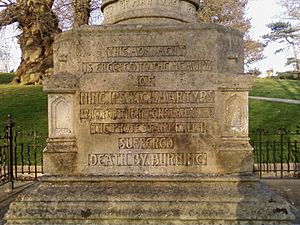Ipswich Martyrs facts for kids
The Ipswich Martyrs were nine people who were burned at the stake. This happened because of their Protestant beliefs between about 1515 and 1558. Most of these burnings took place in the center of Ipswich, Suffolk. The spot was The Cornhill, a square in front of the old Ipswich Town Hall. Later, in 1645, another person named Widow Lakeland was executed there. This was ordered by Matthew Hopkins, known as the Witchfinder General.
Other Protestants were also treated badly in Suffolk during this time. Some were even killed in places like Hadleigh, Beccles, and Long Melford. The most famous was Dr. Rowland Taylor from Hadleigh. He was burned on Aldham Common in 1555. People say his ghost still haunts Hadleigh and Aldham.
Contents
The Ipswich Martyrs
The story of Protestant martyrs linked to Ipswich begins with Thomas Bilney. In 1527, he was preaching about the Reformation in St George's Chapel. He was taken from the pulpit for his beliefs. He had also preached in St Margaret's church.
After being forced to say he was wrong, he was put in the Tower of London. He stayed there for a year. Then he went back to Trinity Hall, Cambridge. In 1531, he bravely spoke about his beliefs again in Norwich. He was then burned at the stake there.
Martyrs on the Ipswich Memorial
The memorial in Ipswich lists these people:
- Nicholas Peke (N. Peke): From Earl Soham, burned in Ipswich in 1515.
- Kerby: Judged in Ipswich in 1546. He was burned in Ipswich. Another man, Roger Clarke, was judged with him and burned in Bury St Edmunds.
- Robert Samuel: A minister from East Bergholt, burned in Ipswich in 1555.
- Agnes Potten: From Ipswich, burned in 1556. She and Joan Trunchfield were burned together in one fire.
- Joan Trunchfield: From Ipswich, burned in 1556 (see above).
- John Tudson: From Ipswich, but he was burned in London in 1556.
- William Pikes: From St Margaret's, Ipswich. He was burned in Brentford in 1558.
- Alexander Gooch: From Woodbridge, Suffolk. He was arrested with Alice Driver. Both were burned in one fire in Ipswich in 1558.
- Alice Driver: From Grundisburgh, Suffolk. She was arrested with Alexander Gooch and burned in Ipswich in 1558 (see above).
Other Martyrs Mentioned by Foxe
The historian John Foxe also wrote about these people:
- Anne Bolton: Burned in Ipswich.
- John and Michael Trunchefielde: Both from St Leonard, Ipswich. They were sentenced to be burned.
- Agnes Wardal: From Ipswich. She was persecuted but managed to escape.
Ipswich Martyrs' Memorial
A special memorial was built for these martyrs in Christchurch Park in 1903. It is close to Christchurch Mansion. You can find it by walking from the front of the mansion towards the children's play area.
The monument has a square stone base. The front of the base tells about the martyrs. Their names are listed on the other three sides. The Art Memorial Company of West Norwood designed and built it. It is 27 ft (8.2 m) tall. Its base is 10 ft 6 in (3.20 m) wide. The base is made of Ketton stone. The tall part is made of shiny red granite.
Funding the Memorial
The Ipswich Martyrs' Memorial was paid for by donations from people. This fundraising started in November 1902. This happened after Nina Frances Layard wrote newspaper articles about the martyrs. These articles were in the East Anglian Daily Times from 1898 to 1900. She then put them into a book called Seventeen Suffolk Martyrs in 1902.
People first hoped to put the memorial on the Cornhill. This was the original spot where the burnings happened. But some local people did not agree with the project. So, the location was changed to Christchurch Park.
Unveiling the Memorial
The memorial was officially revealed on Wednesday, December 16, 1903. The Very Rev. Henry Wace, who was the Dean of Canterbury, led the ceremony. Many important people were there. This included the deputy-Mayor and the M.P. Sir William Brampton Gurdon.
Dean Wace gave a long speech. He talked about how important the martyrs' sacrifice was for the Reformed Faith. He spoke about "justification by faith." This was an idea from Martin Luther. It meant people could connect directly with God. They could ask for forgiveness and blessings without needing another person to help. He said this idea brought a new spirit of life. It also gave people a great sense of freedom.
The Dean also spoke about breaking free from the Church of Rome. He said the Church of Rome was an enemy of freedom. He believed the Reformation was a big change for Europe. It divided Europe into two parts. One part was under Roman control. The other part believed in Christian liberty. He was sure England made the right choice. He said England must never lose that freedom by going back to Rome's control.
He said, "This country has been made by the Word of God." He believed the Bible had a huge effect on English people. He hoped the memorial would help people remember to read the Bible. He also hoped it would encourage simple trust in God. He repeated the famous words of Hugh Latimer to Ridley: "Play the man, for by God's grace we shall today light a candle in England which shall never be put out."
Memorial Texts
The monument has these words carved into it:
"This monument is erected to the memory of nine Ipswich martyrs who for their constancy to the Protestant faith suffered death by burning."
"Oh may Thy soldiers, faithful, true and bold,
Fight as the saints who nobly fought of old,
And win with them the victor's crown of gold.
Alleluia."
See also



